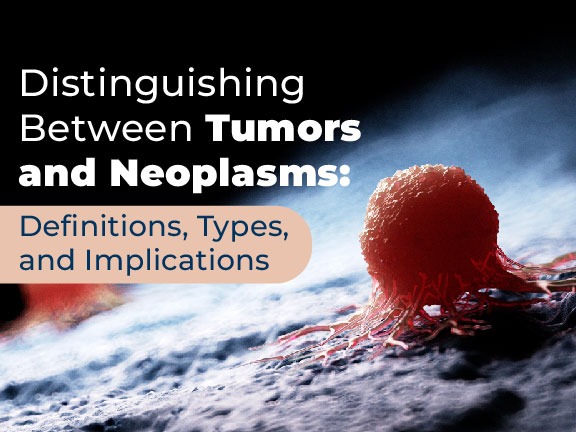Neoplasm refers to an abnormal growth of tissue that forms a mass or tumor. These masses can be either benign, meaning non-cancerous, or malignant, which is cancerous. The main characteristic of a neoplasm is the unregulated division of cells, which leads to the formation of this abnormal growth. While benign tumors may remain localized and not spread to other areas. Malignant tumors have the ability to invade surrounding tissues and metastasize to distant organs, making them more dangerous.
Neoplasm development can be triggered by various factors, including genetic mutations, environmental exposures such as chemicals or radiation, and lifestyle choices like smoking or diet. Malignant growths are particularly concerning because of their aggressive nature. They can disrupt the normal functioning of organs and lead to severe health complications. Early detection through screening and medical imaging is often key to successful treatment, as therapies like surgery, chemotherapy, and radiation can be more effective in the early stages. Additionally, advancements in targeted therapies and immunotherapy offer new hope for treating certain types of aggressive tumors, making it essential for patients to receive timely medical attention.
What are neoplasms? Neoplasms are abnormal growths of tissue, and they can be classified into two main types:
- Benign neoplasms: These are non-cancerous growths that do not invade nearby tissues or spread to other parts of the body. They are usually slow-growing and can often be removed without recurrence.
- Malignant neoplasms: These are cancerous and have the ability to invade nearby tissues and spread to distant organs through the bloodstream or lymphatic system. Malignant tumors grow more rapidly and are more dangerous due to their potential to metastasize.
Understanding the type of neoplasm is crucial for determining the appropriate treatment and prognosis.
Malignant Neoplasm
A malignant neoplasm, often referred to as a malignant tumor, is an abnormal growth of cells that divide uncontrollably and can invade nearby tissues. These tumors have the potential to spread to other parts of the body, a process known as metastasis. The neoplasm definition highlights that it refers to any new, abnormal growth of tissue, but when classified as malignant, it carries a more severe prognosis. The definition of neoplasia describes this condition as the uncontrolled, abnormal proliferation of cells that form a mass, or tumor.
Some specific types of malignant neoplasms include solid pseudopapillary tumors, which typically occur in the pancreas, and adrenal neoplasm, a type of tumor that develops in the adrenal glands. Both of these conditions can be life-threatening if not treated promptly. When asking, “what is adrenal neoplasm” or “what is malignant neoplasm,” the key understanding is that these tumors arise from various tissues and have the potential to grow aggressively. Malignant neoplasm meaning is essentially the same as saying cancerous growth.
Malignant tumors can affect any part of the body, including the skin, lymph nodes, and internal organs. For example, malignant lymph node neoplasm refers to cancerous growths in the lymph nodes, which can occur as a result of cancers such as lymphoma. Similarly, spindle cell neoplasms can appear in soft tissues, characterized by long, spindle-shaped cells. These tumors are often found in the skin and other tissues.
Treatment for cancer tumor varies depending on the type and stage of the neoplasm. Some options include surgery, chemotherapy, radiation therapy, and targeted therapies. Additionally, patients may choose to participate in clinical trials for access to new and innovative treatments. Clinical trials are essential for advancing cancer care and can provide patients with potentially more effective or less toxic treatment options.
The following are important factors in treating malignant neoplasms:
- Type of tumor: Whether the tumor is a solid or a more complex type, such as of uncertain origin.
- Location: Tumors of skin or internal organs require different treatment approaches.
- Treatment options: Surgery, chemotherapy, and radiation are commonly used. Participation in clinical trials is another option.
By understanding these aspects, patients can make informed decisions about their treatment path and take advantage of the latest medical advancements.

In terms of treatment, the presence of neoplastic cells in any part of the body requires a comprehensive approach that might include surgery, radiation, chemotherapy, or a combination of these. The ultimate goal is to control the spread of the disease and alleviate symptoms, thereby improving patient quality of life. The challenge intensifies with metastasis cancer, where cancer cells break away from the original tumor and travel through the body, forming new tumors in other organs.






16 Comments
This was very informative
Hi Lilliana,
We’re happy you found this informative, our goal is to provide useful and informative information to patients and caregivers, we hope our articles help patients navigate and stay informed during their diagnoses.
Thank you very helpful
Greetings Healthcare friend!
I have a friend who had been diagnosis with bladder cancer that was treated with chemotherapy. After testing, the bladder cancer was gone. Now she reports that she has a neoplasm on her left kidney and has been experiencing GI problems. Could this neoplasm be from the bladder cancer?
Thanks for Your reply! I’m just preparing myself!
Sylvia
Hi Sylvia, we are very sorry to hear about your friend. This could be a recurrence of the bladder cancer or a new primary cancer on her kidney. To know for sure, your friend can have a biopsy of the tumor on her kidney to determine its primary location. Once the pathology from the biopsy is resulted, we would be happy to review the results with her/you and support your friend through her journey.
I have been diagnosed with malignant neoplasm of sigmoid colon. Could you explain that for me? My email is ###. The diagnosis code is C18.7 (ICD-10-CM). Thank You.
We are sorry to hear of your diagnosis. A malignant neoplasm of the sigmoid colon is another way of saying colorectal cancer. Malignant means cancerous. There are treatment options and clinical trials available depending on the stage, location, and other factors. We can review your records and see what options you have. Please reach out at [email protected] or 844-627-7246 and we would be happy to support you through this difficult time.
Does a neoplasm has to be removed surgicaly
Whether a neoplasm is removed or not depends on a few factors such as where the neoplasm is located and the stage of the cancer, among other things. We can review your records and see if surgical resection is the best option or if a clinical trial or other treatment might be better at this time. Please reach out at [email protected] or 844-627-7246 and we would be happy to support you.
Hello I had fibroids.but doctor told me it’s neoplasm benign.could you let me what Is this cancer or not?
Hi Jyoti, a benign neoplasm is a non-cancerous growth. So if your doctor has stated that your fibroids are benign, then they are not cancerous. Thank you for reaching out and we are happy that your results came back negative.
I have been diagnosed of oncocytic neoplasm of the right kidney after a renal biopsy and histopathology done
what does that mean please
Hello Vero, without seeing the full pathology report it is difficult to determine exactly what your diagnosis is. At Massive Bio we are happy to abstract your medical records and match you to any clinical trial you may be eligible for. Of course, we encourage you to have these conversations with your oncologist to determine what the best fit is for you.
Thank you so much. Your definition and the difference between tumor and neoplasm / benign and malignant has been helpful to me.
Neoplasma tumor (benign). Take pointer finger and and place in the first joint (closes to three tip) of your thumb. That’s the size and it’s located on the very top of the head. Checked one year later and there was growth. Dr said don’t need to do anything. It was discovered because of on growing symptoms of headaches, dizziness, feeling of eyes rolling back, cricket sound in ears and constant changes in vision with partial vision loss in left eye at time, having memory problems and my mood has become irritable with random speech problems. Sometime I say random words in my sentences and something I can’t get words out and have to think a little while. Eye doctor gave clean bill of health, no diabetes. Should I seek a second opinion?
Thanks for your message. We would be happy to help. You can learn more about available cancer treatment options and clinical trials here: https://hubs.ly/Q01yygDr0.
You can also contact one of our Patient Relations Coordinators via phone or email at 844-627-7246 & [email protected]